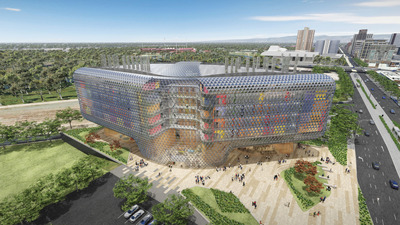Building an energy-efficient medical research institute
Friday, 12 April, 2013
The South Australian Health and Medical Research Institute (SAHMRI) is building a diamond-shaped 25,000 m2 facility designed to foster researchers’ creativity and productivity. Together with Schneider Electric Life Sciences solution experts, SAHMRI aims to maximise operational efficiencies and energy conservation, ensure a reliable and secure environment, reduce risks and achieve regulatory compliance and green building certification.
Key to the building’s success was early engagement with Schneider Electric and the company’s EcoStruxure architecture during the design phase. EcoStruxure integrates SAHMRI’s building systems into a single platform that includes heating and cooling, energy management, security and lab controls, to provide efficiency and flexibility throughout the facility’s life cycle.
The facility’s diamond-shaped construction, elevated on flower columns, also features a pine-cone inspired transparent skin to allow plenty of natural light into the building. It features wet and dry laboratory areas, modern research areas and even a medicinal garden. The facility is scheduled for completion in late 2013.

“We need environments that encourage creativity, the right temperature, right lighting and right systems, to ensure researchers are at their best, most creative and productive,” says Professor Steve Wesselingh, Executive Director, SAHMRI.
The integrated building system (IBS) provides maximum efficiency through a collaborative design, construction and delivery process. The system design uses 3D building information modelling software, to avoid design changes and rework. Because all components communicate with one another, the system allows the facility manager to monitor and control heating, ventilation, air conditioning, humidity, lighting, access control, video, lifts and other security features across the facility.
Integrated security solution
Schneider Electric’s integrated security offering includes smart card access control, closed-circuit video management and high-definition cameras, and monitoring. Each smart card can be programmed to allow access to designated areas only for key personnel and prevent entry to restricted areas such as the laboratory.
The video management system designed for SAHMRI deploys the latest in Pelco by Schneider Electric’s high-definition cameras, with increased capabilities for video analytics and identification - more than standard resolutions. More than 55 cameras have been specified for this site, based on a fully integrated platform incorporating intercom networks.
Intelligent lighting control
Another key component of the EcoStruxure architecture is the DALIcontrol lighting control system, designed to maximise energy efficiencies in the building. Although there are key scenes programmed into the building, the system also allows for customised programming in research areas that require constant lighting to simulate daylight levels of light.
Emergency power supply
It is critical in medical facilities to have the assurance that the backup power system will perform in an emergency. Schneider Electric’s emergency power supply system (EPSS) test solution provides automated analysis and accurate reporting as well as complete power system information. It tests the backup generator supply and gives reports on the precise timing of transfer switches, the condition and health of the generator, monitors EPSS load levels and duration of test, It makes manual testing obsolete, saving time and also collecting data during real outages.
Power interruptions also have the potential to create data loss and hardware damage to all communication and computer equipment. With 18 communication hubs located throughout the building, UPS is being provided to maintain power continuity and protect vital communications equipment.
A monitored power network
Many clients are now asking for more functional energy monitoring and reporting capabilities as part of their electrical distribution network and SAHMRI is no exception. Schneider Electric included their new StruxureWare Power Monitoring 7.0 (SPM7) energy management software platform to better integrate SAHMRI’s energy metering. To achieve even better power quality and reliability outcomes, Schneider Electric collaborated with electrical contractors Nilsen to upgrade the metering hardware to allow for better power-quality event diagnostics and therefore ensure a shorter ‘mean time to repair’ should any electrical network issues arise.
SPM7 will allow the SAHMRI to monitor their entire installation from the utility grade power quality (PQ) meter on their main incomer, to the PQ meters on their sub-sectional feeders; and via low-voltage Masterpact air circuit breakers and Compact NSX moulded-case circuit breakers fitted with Micrologic control units installed on key sub mains. SAHMRI’s project design team, including electrical services consultant Aurecon, also ensured sub-metering was installed strategically in specially designed distribution boards, to separately meter the power and lighting chassis.
Schneider Electric partnered with local energy solution integrator Azzo to deliver this integrated technological solution to maximise the functionality and efficiency of the SAHMRI’s electrical distribution network.
More drive for less input
A facility such as SAHMRI requires an enormous number of pumps, fans and motors to ensure the HVAC system is operational. These consume vast amounts of energy, however the SAHMRI design team has conserved as much energy as possible with the addition of Schneider Electric’s Altivar variable speed drives. These will limit energy usage on start-up and allow for the precise control of heating and cooling through the IBS.
Team of local experts
Local representation was an important prerequisite for SAHMRI as, in the event of any technical issues, Schneider Electric could quickly resolve them and limit any project delivery delays
Meeting certification standards
Schneider Electric’s solution also helps the SAHMRI building meet Leadership in Energy and Environmental Design (LEED) certification standards. This is a globally recognised standard in ensuring that a building project is environmentally responsible, profitable and a healthy place to work.
Tackling energy insecurity in remote communities
Researchers from Flinders and Macquarie Universities have presented the benefits of community-led...
Paper-thin LEDs that are kinder to the eye
A new, experimental LED is nearly as thin as paper and emits a warm, sun-like glow.
How clear windows can harvest energy
Researchers have created a colourless solar concentrator that can be directly coated onto...




